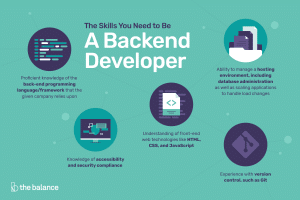Understanding the Basics of Website Backend Development

Website backend development plays a crucial role in the functionality and performance of any web application. While frontend development deals with what users see and interact with, the backend is responsible for handling data, server requests, and overall site operation. In this article, we will explore the basics of website backend development, focusing on the key concepts, technologies, and skills required.
What is Website Backend Development?
Backend development refers to the server-side of web applications, where the logic, database interactions, and server management take place. It involves writing code that enables a website to function correctly, handle requests, process data, and return appropriate responses to the frontend. In essence, backend developers ensure that everything behind the scenes operates seamlessly.
Key Components of Backend Development
Backend development consists of several vital components that work together to ensure the smooth operation of a website:
- Servers: A server is a computer that hosts a website, processes user requests, and sends data back to users. Backend developers work with server environments to ensure efficient and secure communication.
- Databases: Websites store and retrieve data from databases. A backend developer manages how data is saved, updated, and retrieved from databases like MySQL, MongoDB, or PostgreSQL.
- APIs (Application Programming Interfaces): APIs are tools that allow different software applications to communicate. Backend developers often create or work with APIs to integrate third-party services or enable communication between the frontend and backend.
- Programming Languages: Backend development requires the use of server-side programming languages, such as Python, Ruby, PHP, Java, or Node.js. These languages are responsible for the logic that powers web applications.
- Frameworks: Frameworks like Django, Laravel, Flask, or Express provide a structured way to develop backend systems, saving time and reducing repetitive coding tasks.
The Role of the Backend Developer
the Basics of Website Backend Development. Backend developers focus on building the foundation that makes websites function. Their tasks include database management, server management, and implementing the logic that ensures user data is handled correctly.
Backend Developer Responsibilities
Backend developers are responsible for:
- Database Management: They design, maintain, and query databases to ensure data is stored and retrieved efficiently.
- Server Management: Backend developers manage server infrastructure, ensuring that it operates without issues like crashes or slowdowns.
- Writing Code: They write server-side code using programming languages to handle requests, authenticate users, and manage interactions with the database.
- Security Implementation: Ensuring that a website is secure from threats like data breaches, SQL injection, and other vulnerabilities is a critical part of backend development.
- API Integration: Backend developers often work with APIs to connect different services and enable complex interactions between various components of an application.
Backend Development Technologies
A range of technologies is used in backend development, and understanding them is crucial for any aspiring developer.
Programming Languages
There are several languages commonly used in backend development:
- Python: Known for its simplicity and readability, Python is widely used in backend development, especially when working with frameworks like Django or Flask.
- Node.js: A JavaScript runtime, Node.js allows developers to use JavaScript for backend development, making it easier to work with both the frontend and backend in the same language.
- PHP: A server-side language used for building dynamic websites. It’s popular for use with content management systems like WordPress.
- Ruby: Known for its simplicity, Ruby, along with its framework Ruby on Rails, is a popular choice for building scalable applications.
- Java: A versatile language used for both enterprise-level applications and smaller web applications due to its performance and scalability.
Databases

Databases store and manage data used by web applications. There are two types of databases commonly used in backend development:
- Relational Databases: These databases, like MySQL and PostgreSQL, store data in tables with relationships between them. They use structured query language (SQL) to manage and retrieve data.
- NoSQL Databases: Unlike relational databases, NoSQL databases like MongoDB store data in a flexible, schema-less format, making them suitable for handling large datasets or real-time data processing.
Frameworks
Frameworks help developers by providing pre-built modules and structures for faster and more efficient coding. Some popular backend frameworks include:
- Django: A high-level Python framework that encourages rapid development and clean, pragmatic design.
- Laravel: A PHP framework that focuses on simplicity and elegance, making backend development more straightforward.
- Express: A fast, unopinionated framework for Node.js that simplifies web and mobile application development.
- Ruby on Rails: A full-stack framework for Ruby that emphasizes convention over configuration, allowing developers to focus on application logic rather than setup.
Backend Development Best Practices
To excel in backend development, it’s essential to follow best practices that improve performance, scalability, and security.
1. Code Efficiency
Writing clean, efficient code reduces server load and ensures faster response times for users. Backend developers should optimize code to minimize resource consumption and avoid unnecessary database queries.
2. Security Implementation
Security is paramount in backend development. Protecting sensitive data, ensuring secure user authentication, and defending against threats like SQL injection or cross-site scripting (XSS) are critical responsibilities. Developers should implement security protocols like HTTPS and encryption and follow security guidelines to protect user data.

3. Scalability
As websites grow, backend infrastructure must handle increasing traffic and data loads. Designing scalable solutions, like using load balancers and optimizing databases, ensures that websites can handle more users without performance degradation.
4. Testing and Debugging
Regular testing is crucial to ensure that backend systems run smoothly. Unit testing, integration testing, and debugging help identify and fix issues before they affect the user experience.
Learning Backend Development
If you’re interested in becoming a backend developer, there are several steps you can take to build your skills:
- Learn Programming Languages: Start by mastering a server-side programming language like Python, PHP, or Node.js.
- Understand Databases: Learn how databases work and practice using both SQL and NoSQL databases.
- Explore Frameworks: Familiarize yourself with popular frameworks like Django, Laravel, or Express to streamline your development process.
- Work on Projects: Practice by building real-world projects, such as a simple web app with user authentication and database interaction.
Conclusion
Backend development is the backbone of web applications, ensuring that everything runs smoothly behind the scenes. From server management to database interactions and security, backend developers play a vital role in web development. By mastering programming languages, working with databases, and following best practices, you can become a proficient backend developer capable of building scalable, secure, and efficient web applications. the Basics of Website Backend Development.





